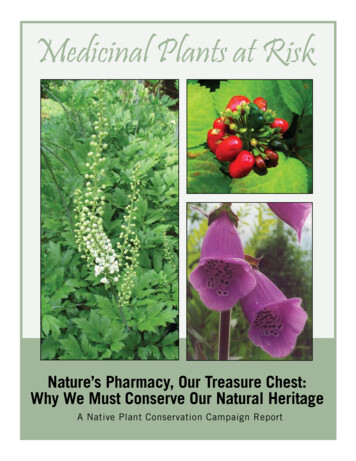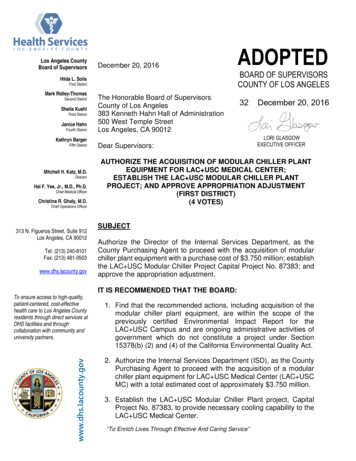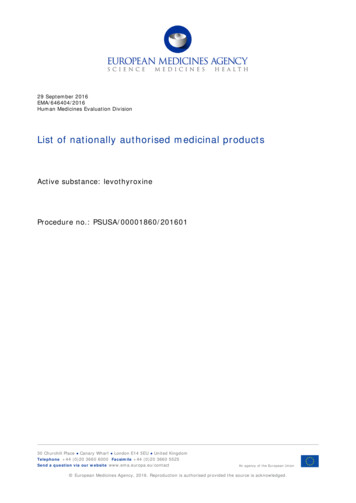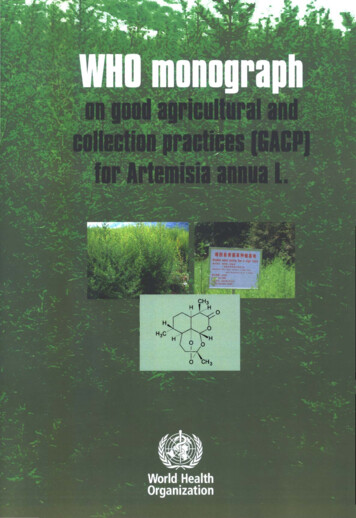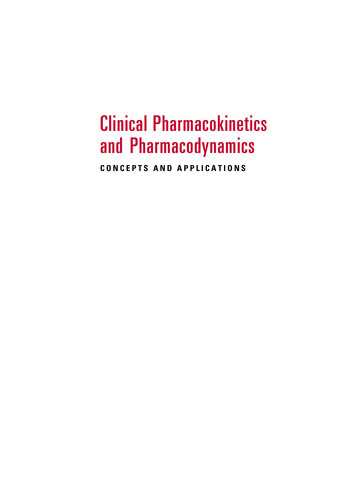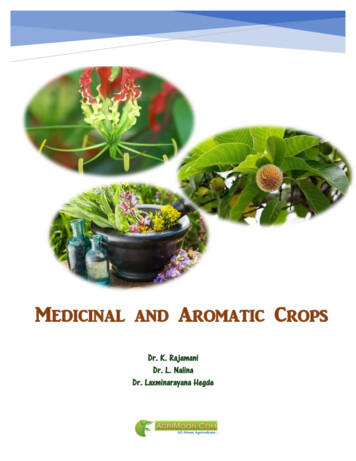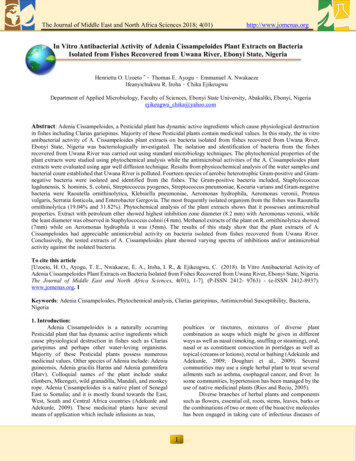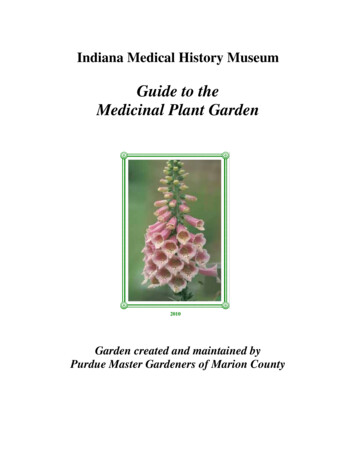
Transcription
Indiana Medical History MuseumGuide to theMedicinal Plant Garden2010Garden created and maintained byPurdue Master Gardeners of Marion County
Guide to the Medicinal Plant Gardenat theIndiana Medical History MuseumTable of ContentsDisclaimerAbout the Indiana Medical History MuseumIntroduction to the GardenPlants in the Garden: A-GPlants in the Garden: H-ZAdditional Important Medicinal PlantsTypes of Medicinal Herbal PreparationsSelected ReferencesAcknowledgmentsDirections to the GardenList of Common Names and Scientific NamesList of Scientific Names and Common NamesPhotos of Selected Plants
Disclaimer“Demonstration - Not Prescription”The purpose of the Medicinal Plant Garden at the Indiana MedicalHistory Museum is to demonstrate some of the plants that have beenthe source of medicines in the past and present and to shareinteresting historical information. In providing this garden andrelated written materials and presentations, the museum and MasterGardeners do not intend to endorse the use of current herbalremedies.Individuals should consult with their health care professionals andmake their own informed decisions before taking any medicine,herbal or otherwise.Medicinal plants can be toxic. Do not pick or ingest any part of theplants in the garden.Indiana Medical History Museum3045 West Vermont Street, Indianpolis, Indiana, 46222(317) 635-7329, Edenharter@imhm.org, www.imhm.orgBrochure text by Kathleen Hull, MDPhotographs by Meredith Hull, MD and Kathleen Hull, MDCopyright 2010 Kathleen Hull2
About the Indiana Medical History MuseumThe Indiana Medical History Museum is dedicated to preserving the heritage of the healing arts inIndiana. Through its exhibits and publications, the museum educates the public concerning healthcare in Indiana, particularly during the nineteenth and first half of the twentieth centuries.Museum programming also focuses on the life sciences and health careers.The IMHM is located in the old Westside of downtown Indianapolis, occupying part of theformer Central State Hospital’s 160 acre campus. The main building of the museum is the OldPathology Building of Central State Hospital, which was a hospital for patients with psychiatricdiscorders. It is listed in the National Register of Historic Places and has been identified as anofficial project of “Save America’s Treasures” by the National Trust for Historic Preservation.This outstanding building was designed and built under the supervision of Superintendent Dr.George Edenharter. It was dedicated in 1896 as a state-of-the-art research and education facilityenabling hospital physicians to apply scientific methods in their study of mental diseases. Thisunique structure survives intact with its original amphitheater, library, and laboratory furnishings.Tours of the museum bring to life the era of early medical research, education, and practice.The IMHM has restored a smaller adjacent building as the site of a doctor’s office exhibit thatinterprets a typical rural physician’s practice of the mid-20th century, exploring the transition fromthe healthcare of the 1800’s to the era of modern medicine. The exhibit contents comprise theintact office of Dr. Marion Scheetz of Lewisville, Indiana. The artifacts were donated by hisdescendants, and the display was made possible in part by a grant from the Indiana Academy ofFamily Physicians.The Medicinal Plant Garden was added to the grounds south of the Old Pathology Building in thespring of 2003. It is the project of a group of Purdue Master Gardeners of Marion County whodesigned, installed, and maintain the garden. Garden supplies, plants, and gardening hours allhave been donated to the museum.The museum is open to the public 10 a.m. to 4 p.m., Thursday through Saturday and at othertimes by appointment. The last tour begins at 3:00 p.m. Groups of ten or more should make tourarrangements by contacting the museum. Admission is 5 for adults, 1 for students 18 years oldand under, and free for children under 5 years old. Visit or contact the museum at 3045 WestVermont Street, (317) 635-7329, Edenharter@imhm.org, and www.imhm.org.3
The Indiana Medical History Museum is a private, nonprofit organization. It is not part of anyState, historical, medical, or pharmaceutical organization. Memberships and donations helppreserve the historical artifacts of Indiana’s past. All donations in support of the museum andgarden are welcome.Brief History of Central State Hospitaland the Indiana Medical History Museum1848Indiana Hospital for the Insane opened – 5 patients1889Name changed to Central Indiana Hospital for the Insane1896Opening of separate Pathological Department building for the education andscientific study of diseaseArchitect – Adolph Scherrer1903(IU School of Medicine was established – two years of study in Bloomington)1910Flexner Report revolutionized medical education in the US and Canada1926Name changed to Central State Hospital1930sMany of the outdated laboratory facilities in the Pathological Departmentno longer used1956Last year that IU SOM medical students had neurology and psychiatry classes inthe amphitheater – because of the opening of LaRue Carter Hospital at IUSOM1969Non-profit organization formed to preserve the building: Dr. Charles Bonsett,Dr. John Keating, Dr. Dwight Schuster, Dr. William Sholty, and Mrs. Donald (Dorothy) White;known as “Indiana Medical History Foundation”1972IMHM’s Old Pathology Building (OPB) added to the National Register ofHistoric Places and to the Historic American Buildings Survey1985Name of Indiana Medical History Society changed to “Indiana Medical History Museum”1986Indiana State Legislature provided IMHM with a 99-year lease for the OPB and5.24 acres, for fee of 1 per year1994Central State Hospital is closed.1995The pathology building at Bellevue State Hospital (New York) was razed, leavingOPB as the last free-standing pathology building of its kind2001OPB designated in White House and National Trust’s “Save America’s Treasures” program2003Addition of Medicinal Plant Garden2004City of Indianapolis purchased CSH from State2005Doctor’s Office Exhibit opens - Indiana Academy of Family Physicians sponsorship4
Introduction to the GardenIn this modern era of urban civilization, many of us have lost touch with nature. We no longerhave the intimate knowledge of plants and their uses that our ancestors had acquired throughcenturies of trial and error. When we want a cure for our headache or fever, we go not to themeadow and woodland but to the drugstore.The Medicinal Plant Garden of the Indiana Medical History Museum offers the opportunity toremember that plants were the original source of most medicines. Many of the miracle drugs oftoday are molecules or variations on compounds that were originally available from plantmedicines. For example, Bayer Aspirin (acetyl-salicylic acid) had its beginnings in 1897 from acompound that occurs naturally in the herbaceous perennial European meadowsweet.In recent decades, in the United States people have had an increasing interest in using herbalremedies. A wide variety of herbal preparations are available over the counter at mostpharmacies and grocery stores. It is important to treat these substances with care. Just because aproduct is “natural” does not mean that it is safe. As with our modern drugs, herbal medicinesmay have undesired side effects as well as potential beneficial effects. For example, anindividual taking feverfew (Tanacetum parthenium) for migraine headaches may not realize thatit acts as an anticoagulant and could result in bleeding complications if surgery is needed. Whenasked by the doctor, “What medicines are you taking?” one always should include any herbalremedies or tonics taken regularly in the answer.In this country, the efficacy and strength of commercial herbal preparations is not controlled bygovernmental regulations at this time. They are considered to be food supplements rather thandrugs. The potency of herbal remedies in stores is difficult to predict. Studies even show thatsome products on the market have no active ingredient present. By contrast, in Europe,Germany’s Commission E carefully studies and makes recommendations about herbal medicines,and products available are better standardized and regulated. Of course, the amount of activecompounds in a plant's flower, leaf, bark, or root will vary with the cultivar, the soil, the weather,the time of year, the time in the plant’s life cycle at harvest, and the way in which the plant isdried, preserved, and processed.Some of the most beautiful medicinal plants are quite poisonous. Examples include foxglove(digitalis), autumn crocus (colchicine), castor bean (ricin), mayapple (podophyllotoxin), and lilyof the valley (digitalis-like cardiac glycoside). Remember that many of the plants we haveincluded in this garden can be toxic if misused. Please, do not pick or eat any part of theplants in the garden!This brochure offers interesting information about the plants in the garden, presentedalphabetically according to their most-used common name. The information includes thecommon name, scientific name, (previous scientific name), a brief description of the plant’s mainmedicinal uses and history, indication of where it began as a native plant, and the parts of theplant that are or were used medicinally. Alphabetical lists of common and scientific names are atthe end of the brochure. More extensive information about some of the plants is available in themuseum.5
Plants in the GardenAlfalfaMedicago sativaIn Arabia this plant was called al-fac-facah, meaning “the father of all food” and leading to thecurrent English common name alfalfa. This plant, which looks similar to clover, was used byhealers in ancient China and India and by American settlers to treat ulcers and other digestiveproblems. While traditional uses have not been proven to be effective, recent research indicatesthat alfalfa leaves may help lower cholesterol and absorb carcinogens in the intestines. The seedscontain two chemicals that may promote menstruation, and alfalfa seeds should not be consumedduring pregnancy. The plant’s coumarins and isoflavones have some estrogenic effect.Asia, Europe, North AfricaLeavesAloe veraAloe barbadensisThis plant may be named from the Arabic word alloeh, which means “bitter and shinysubstance.” Aloe has been used medicinally for centuries, especially to soothe and aid thehealing of burns. Research shows that one of its active ingredients is bradykinase, which is aprotease inhibitor that relieves pain and decreases swelling and redness. Another ingredient,germanium, is a fast-acting pain killer. Aloe gel taken internally is a powerful purgative. Aloegrows better as a houseplant than it does out in gardens in Indiana.Africa, West IndiesLeavesAmerican skullcapScutelleria laterifloraThe aerial parts of this plant were widely used as a sedative to calm the nervous system, servingas a “nervine” or “nerve tonic.” It was recommended for a wide variety of states, such ashysteria, convulsions, insomnia, delirium tremens, and pre-menstrual tension. Cherokees usedskullcap to stimulate the uterus – promoting menses or expelling the placenta after childbirth. Theplant also reportedly had hypotensive and anti-spasmodic effects. Modern herbalists alsorecommend skullcap for anorexia nervosa and fibromyalgia; however, few studies have beendone to show evidence that the plant has significant medicinal effects.AmericaAerial partsAngelicaAngelica sinensis, A. archangelicaChinese angelica (A. sinensis, known as Dang Gui and Dong Quai) in combination with otherherbs has been used in the East for centuries to treat gynecologic problems and a variety of otherailments. Recent studies of its effectiveness have shown mixed results. Chinese angelica maystimulate formation of blood clots. European angelica (A. archangelica) was associated withwitchcraft and magic. Drinking “angelica water” or “the King’s Excellent Recipe for thePlague,” which was made from squeezing the root of this plant and mixing the juice with nutmegand treacle, was a popular though probably ineffective protection against the plague in the 1600’s.The plant was used in Europe and America to treat respiratory diseases, as were a variety of otherhollow-stemmed plants. Colonists also used the plant as an abortifacient. Recent studies indicatethat compounds in European angelica act as calcium channel blockers – similar to verapamil. Theroots and seeds of A. archangelica are used as flavoring for Benedictine and Chartreuse liquors,gin, and vermouth. Caution: the sap and oil of angelica left on the skin may cause severephotodermatitis – ulcerated skin lesions after exposure to sunlight (photodermatitis).Asia, EuropeRoots; Roots and Aerial parts6
Arborvitae treeThuja occidentalisThese upright evergreen trees in the garden are members of the Cypress family. The scale-likeleaves gathered in summer produced a medicine that Native Americans used for fever, cough,headache, rheumatism, and other ailments. Research has shown antiviral activity against wartsand polyps and possible anti-neoplastic activity against uterine cancer. It has been used forbronchitis, cystitis, and several other conditions as well. Arborvitae preparations should be takenonly under professional supervision. The heartwood of these trees is light weight and decayresistant, and it was used to make the ribs of canoes.AmericaLeavesAutumn crocusColchicum autumnaleThere are two kinds of fall blooming crocus. The smaller Crocus sativus is a true crocus, amember of the Iris Family, and the source of the spice saffron, which consists of the dried stigmasof the flowers. Colchicum autumnale is a larger crocus-like flower that blooms in the fall and is amember of the Lily Family. This flower comes up after the leaves have faded, a trait leading toanother common name for the plant, “naked lady.” The modern medicine colchicine is derivedfrom dried seeds and is an effective treatment for gout but can also be a deadly poison. Itdecreases the inflammatory response to uric acid crystals and inhibits the deposition of crystals intissue, thereby decreasing the severe pain of gouty attacks. All parts of C. autumnale arepoisonous, and toxic doses result in a condition similar to acute arsenic poisoning.EuropeSeedsAztec sweet herbPhylla dulcis (Lippia dulcis)The Aztec Classic Codex of 1552 recommended the root as a treatment for cough, and the leavesdo have demulcent, expectorant qualities. The dried leaves contain hernandulcin, a sesquiterpenecompound stated to be 1000 times sweeter than refined sucrose. But, the leaves should not beused as sweetener because they also contain camphor, which makes this herb quite toxic. Teamade from the leaves has been used externally on cuts and abrasions and as a mouthwash to fightgum disease and tooth decay.MexicoLeavesBaikal skullcapScutellaria baicalensisAlso known as Chinese skullcap or Huang-qin, the root is used to treat a wide variety ofconditions, including respiratory infections and inflammations. Other uses include improvingbrain function, lowering blood pressure and cholesterol, diuresis, and improving digestion.Baicalin, a component in the root, has antifungal actions and may be antiviral as well.SiberiaRootsBalloon flowerPlatycodon grandiflorusRobert Fortune, who is best known for introducing tea plants from China to India, sent the rootsof the balloon flower plant from China to the Horticultural Society of London at Chiswick,England in 1844. In Traditional Chinese Medicine since at least 100 AD, the bitter platycodonroot (Jiegeng) has been used in combination with other herbs for a variety of conditions, butespecially as a “phlegm-loosener” for lung and throat ailments and for the treatment of abscesses.Young dried roots also were used as a source of dietary starch after being blanched to remove thebitter saponin that is the plant’s medicinal component.AsiaRoots7
BasilOcimum basilicumThe leaves of sweet basil are used in cooking to make pesto and flavor many dishes.Medicinally, the leaves of sweet and other basils have been used to treat indigestion and skinconditions. In India and Thailand, basil seeds are used to calm mucosal membranes, providingrelief for mucous discharges, diarrhea, and coughs. Seeds and leaves eaten as a source of bulkfiber have been used for constipation and to prevent rapid rise in blood sugar after meals. Thepresence of the carcinogen estragole in basil is a concern, and the herb is not approved formedicinal use by Germany’s Commission E. Medicinal basil should not be used by pregnantwomen.Mediterranean, AsiaLeaves, SeedsBee balm, Wild bergamotM. didyma, Monarda fistulosaThe Oswego Indians of New York taught the colonists how to use Bee balm to make a pungenttea that could treat colic, stomach ache, intestinal worms and several other conditions. A weakerversion of the drink became commonly used after the Boston Tea Party. Both the tea and theplant were known as “Oswego tea.” Seeds of the plant were sent from Philadelphia to England inabout 1744, where it was introduced and used as a substitute for tea from Asia. It then spread tocontinental Europe where it was sometimes called “Indian nettle.” Like thyme, bee balms containthe active antiseptic ingredient thymol, and the plants were used to make antiseptic wash forcutaneous and oral inflammation. M. fistulosa (wild bergamot) is taller and has lavender coloredflowers. There are many cultivars of M. didyma (bergamot, Oswego tea, scarlet bee balm) andthese plants generally are shorter and have red, pink, or purple flowers. Bee balm plants are notthe source of oil of bergamot, which actually comes from an Asian citrus tree now largelycultivated in Italy.AmericaAerial partsBlack cohoshActaea racemosa (Cimifuga racemosa)Recent research has confirmed that the black roots of this perennial woodland plant containsubstances with estrogenic, anti-inflammatory, sedative, and hypoglycemic effects. It was usedby Native Americans traditionally to treat “female ailments,” and is marketed today not only fortreatment of menstrual cramps, PMS, and symptoms of menopause but also for rheumaticproblems and as a remedy for high blood pressure. The plant would like more shade than it getsin our garden.AmericaRootsBlack haw shrubViburnum prunifoliumThis deciduous shrub is native to the American woodlands. The bark of the branches and rootscontains many active compounds, including coumarin and salicin that have anticoagulant andaspirin-like qualities, respectively. The plant’s medicinal use is mainly related to its strong antispasmodic properties. Native Americans used it to abate heavy or painful menstrual bleeding andthreatened miscarriage. It was also used for cramping conditions of the intestine, bile ducts, andbladder. As a smooth muscle relaxant, it may help in asthma and hypertension by openingairways and peripheral blood vessels.AmericaBark, Root bark8
Blackberry lilyIris domestica (Belamcanda chinensis)Blackberry “lily” actually is a member of the Iris Family. This common name comes from theprominent clusters of black seeds that stay on the end of the stalks long after the flowers havefaded and the plant gone dormant. Another common name “leopard flower” derives from thespotted appearance of the petals. The rhizomes of this plant are the Chinese herbal substanceShe-Gan. In traditional Chinese Medicine, it is used for asthma, croup, swelling and pain in thethroat, and several other conditions. In the 200s, laboratory studies have shown that blackberrylily extract has some activity against the cells of prostate cancer. Seeds of the plant were broughtfrom Asia to Europe by Jesuit priests in the 1730’s. The plant found its way to America in theearly 1800’s.AsiaRhizomeBlack-eyed SusanRudbeckia hirta and other speciesRudbeckia is a biennial or short-lived perennial. The daisy-like composite flowers have brightyellow ray petals surrounding a prominent dark brown or black center. Another aommon name is“ox-eye daisy.” Native Americans used tea made from the roots to expel worms and treat colds.Juice of the root was a treatment for earache, and a wash was used externally to soothe sores,snakebite, and swelling. The genus name of the plant honors one of the teachers of CarlLinnaeus, Olaus Rudbeck who was professor of botany at the University of Uppsala. Someindividuals have a contact sensitivity to the plant.AmericaRootsBlazing star, Gay-featherLiatris spicataLiatris spicata and a number of other Liatris species send up tall feathery spikes of purple orwhite flowers in the summer. Tests on members of this genus have shown anti-cancer properties.In Europe, liatris is used for gynecologic problems and as a diuretic and a gargle for sore throat.“America’s first botanist,” John Bartram of Philadelphia, included Liatris in his 1751compendium, calling it “throatwort” and noting that chewing the tuber could cure sore throat. Anolder common name “colic root” came from its use for gastrointestinal complaints.AmericaRootsBloodflowerSee MilkweedsAsclepias curassavicaBlue false indigoBaptisia australisNative Americans used hot root tea as an emetic and purgative and cold tea to prevent vomiting.They also applied the root directly to ease toothache. A poultice of false indigo had antiinflammatory effects. This plant may prove to be an immune system stimulant. CherokeeIndians and early settlers used this native plant to make blue dye. The name “false indigo”distinguished it from true indigo (Indigofera tinctoria), a plant native to India that was cultivatedin the American colonies as a source of blue dye made from its leaflets and branches – the dyethat makes blue jeans blue. Baptisia australis has been named the “Perennial Plant of the Year2010” by the Perennial Plant Association.AmericaRoots9
BonesetEupatorium perfoliatumBoneset probably got its name because of its ability to ease the severe muscle and joint pains ofbreakbone fever, which is known now to be a non-fatal mosquito-borne viral disease that causeshigh fever and rash and that also is known as dengue fever. The stem of the boneset growsthrough (perforates) the fused pairs of leaves, hence the species name Eupatorium perfoliatum.Native Americans and pioneers both used a tea made of the aerial parts of the dried plant to treatcolds and malaria. The pioneers of Indiana gathered large bundles and dried them for use throughthe winter. This herbal reduces fever by inducing sweating. Boneset was listed in the USPharmacopoeia and US Dispensatory for decades as the standard treatment for influenza. Use ofboneset in large doses may damage the liver and kidneys or lead to internal hemorrhage.AmericaAerial partsBorageBoragio officinalis*Borage is native to the Mediterranean area but is cultivated widely. The plant is dried at the timeit is in flower. It is effective as a poultice or infusion externally for inflammed or sore skin.Internal use is considered unsafe, except for borage seed oil, which is useful for rheumatic,cutaneous, and premenstrual or menopausal complaints. Borage seed has a very highconcentration of the essential fatty acid gamma linoleic acid (GLA) that is involved in sensitivityto the hormone prolactin (see also Evening primrose). In the Middle Ages, borage flowers andleaves were added to wine that was drunk to dispel melancholy. The herbalist Gerard wrote thatborage was good “for the comfort of the hart, for driving away of sorrowe, and increasing the joieof the minde.”MediterraneanAerial parts, SeedsButterfly weed, Pleurisy rootSee MilkweedsAsclepias tuberosaCalendula, Pot marigoldCalendula officinalisThis annual plant has many medicinal uses. The bright yellow-orange flowers are harvestedwhen in bloom. They contain active ingredients with antiseptic and astringent properties and areused on the skin for rashes, wounds, fungal infections, diaper rash, sore nipples, and varicoseveins. Fresh flowers can be rubbed on the skin to relieve insect stings. Calendula flower tea istaken internally for inflammations of the alimentary tract, to promote menstruation, and as acleansing detoxifying herbal tonic. Calendula, which is known as Pot marigold, should not beconfused with the more common garden marigolds, which are annual plants of a different Genus– Tagetes.Europe, MediterraneanFlowers*Many of the plants in the garden have a scientific species name ending in “officinalis”or“officinale.” This indicates that the plant was the specific one in a Genus that would be found“in the office” of the physician, apothecary, or pharmacist.10
Castor beanRicinus communisGood old castor oil is made from the pretty spotted beans of this large exotic-looking annualplant. The seeds’ oil is almost colorless and without a strong odor, but it has a highly nauseatingdisagreeable taste. Castor oil was widely used as a laxative in acute, temporary constipation,especially in children and the elderly. (Note: The children’s laxative called Fletcher’s Castoria ismade from Senna, not castor oil.) A topical ointment of castor oil also was used for leprosy,ringworm, and itching skin lesions. The oil had many other uses, such as making soap, artificialrubber and leather, candles, furniture polish, and cleaning solution for oil paintings. In ancientGreece and Egypt the plant was valued for its oil for lamps and unguents. The seeds contain avery powerful poison (ricin), but ricin is water soluble and is not present in processed castor beanoil. Ricin is a potent cytotoxin, and when ingested it quickly damages the cells lining the GI tractresulting in abdominal pain, vomiting, and often bloody diarrhea, followed by dehydration, lossof renal function, and hypotension. Death or recovery is expected in 3-5 days. Castor bean plantsin the garden should not be allowed to flower or set seeds when children are present and likely tobe attracted to the pretty beans, because a single chewed bean can be fatal. Also, children shouldnot be allowed to play with necklaces or bracelets made from the spotted beans.Africa, IndiaSeedsCatalpa treeCatalpa bignonioidesSome of the largest trees on the museum grounds are catalpas, recognizable by their coarselygrooved bark, heart shaped leaves, and long cigar-like seed pods. There are two speciesrepresented. C. speciosa (known as Western catalpa, Northern catalpa, and Hardy catalpa) has ataller, narrower, rectangular overall appearance and is not medicinal. C. bignonioides (known asEastern catalpa, Southern catalpa, American catalpa, Indian bean tree, and Fish bait tree) has amore rounded shape and has been used medicinally. Its catalpa leaves were used as poultice forwounds, and tea made from seeds treated bronchitis and asthma. Tea made from the bark hadantiseptic, laxative, and sedative properties. Plus, it was used to expel intestinal worms and as asnakebite antidote. Other species of catalpa in China also were used as medicine for worminfestations.AmericaBark, Seeds, LeavesCatnip, CatmintNepeta catariaThe leaf and flower of this plant contain a compound that causes euphoria in cats. Trappers usedcatnip as bait when going after bobcats and mountain lions. Traditionally, as a medicine it wasused for “obstruction of the womb,” and weak catnip tea was a remedy to soothe a colicky baby.Catnip induces sweating and can bring down the fever of colds and flu. It has been used to treatdigestive tract problems, including use as an ointment for hemorrhoids. Catnip should not betaken during pregnancy.EuropeAerial parts11
Cayenne peppersCapsicum annuum and frutescensMedicinal capsaicin is present in the perennial Tabasco pepper, chili pepper plants (C. frutescens)and also in annual chili pepper, paprika, bell pepper plants (C. annuum). Many of the pepperswere native to tropical America and were introduced to Europe in the 1400’s. Capsaicincontaining topical preparations are used as analgesics for muscle spasms and arthritis. They maybe useful as neuritic pain relievers in conditions such as shingles, post-herpetic neuralgia,trigeminal neuralgia, and possibly diabetic neuropathy. The mechanism of action is not yetdetermined, though it may be related to temporary depletion of neurotransmitters in nerveendings. Taken internally, capsaicin increases circulation and may stimulate blood flow to thehands and feet.Tropical AmericaFruitsChamomileThe nomenclature of chamomile is somewhat confusing. Roman chamomile (Anthemis nobilis orChamaemelum nobile), also known as English chamomile or Garden chamomile, is a slowgrowing perennial. German chamomile (Matricaria chamomilla, M. recutita), also known both asGenuine chamomile and False chamomile by different parties, is an annual. Both were broughtfrom Europe by the pioneers and used to treat “female problems.” A weak tea was drunk to settlethe stomach and improve a variety of intestinal complaints. Ancient Egyptians used chamomile’spower to reduce fevers in malaria. Chamomile tea has excellent calming, relaxing qualities andcan be used to alleviate stress-related problems. It has some pain relieving properties and hasbeen used for menstrual pain and to ease contractions during childbirth. It also has antibacterial,antifungal, antihistaminic, antiseptic and anti-inflammatory properties. Greeks called it “groundapple” because of its scent, and Spaniards called it “little apple” and used it to flavor sherry.Chamomile also has been used as a hair rinse for blond hair.EuropeFlowersChaste treeVitex agnus-castusThe great ancient herbalist Dioscorides wrote De Materia Medica in about 77 CE. In it, hedescribed how using the plant Vitex could promote lactation and menstruation and decreaseinflammation of the uterus. Nearly 2000 years later, herbalists in Europe still use Vitex agnuscastus as an herb to regulate menstrual cycles. Its plant compounds have progesterone-likeeffects. The plant has not been used much in the United States until recently. Vitex is alsoknown as “the chaste
herbs has been used in the East for centuries to treat gynecologic problems and a variety of other ailments. Recent studies of its effectiveness have shown mixed results. Chinese angelica may stimulate formation of blood clots. European angelica (A


